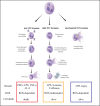Neutrophil extracellular traps and complications of liver transplantation
- PMID: 36466888
- PMCID: PMC9712194
- DOI: 10.3389/fimmu.2022.1054753
Neutrophil extracellular traps and complications of liver transplantation
Abstract
Many end-stage liver disease etiologies are attributed to robust inflammatory cell recruitment. Neutrophils play an important role in inflammatory infiltration and neutrophil phagocytosis, oxidative burst, and degranulation. It has also been suggested that neutrophils may release neutrophil extracellular traps (NETs) to kill pathogens. It has been proven that neutrophil infiltration within the liver contributes to an inflammatory microenvironment and immune cell activation. Growing evidence implies that NETs are involved in the progression of numerous complications of liver transplantation, including ischemia-reperfusion injury, acute rejection, thrombosis, and hepatocellular carcinoma recurrence. NETs are discussed in this comprehensive review, focusing on their effects on liver transplantation complications. Furthermore, we discuss NETs as potential targets for liver transplantation therapy.
Keywords: acute rejection; hepatocellular carcinoma recurrence; ischemia-reperfusion injury; liver transplantation; neutrophil extracellular traps; therapeutic targets; thrombosis.
Copyright © 2022 Liu, Yan, Bin, Qin and Wu.
Conflict of interest statement
The authors declare that the research was conducted in the absence of any commercial or financial relationships that could be construed as a potential conflict of interest.
Figures





References
Publication types
MeSH terms
LinkOut - more resources
Full Text Sources
Medical

